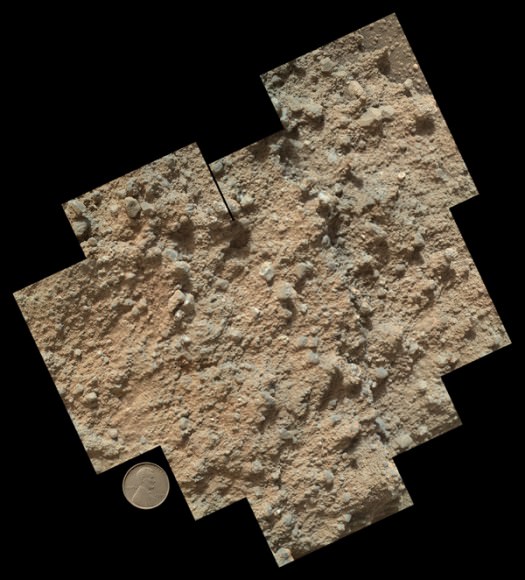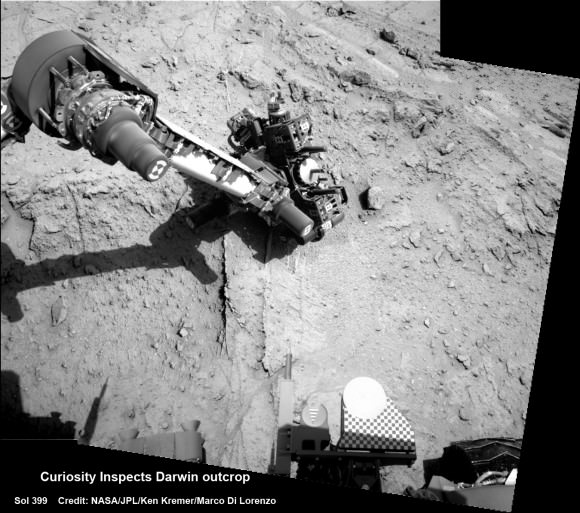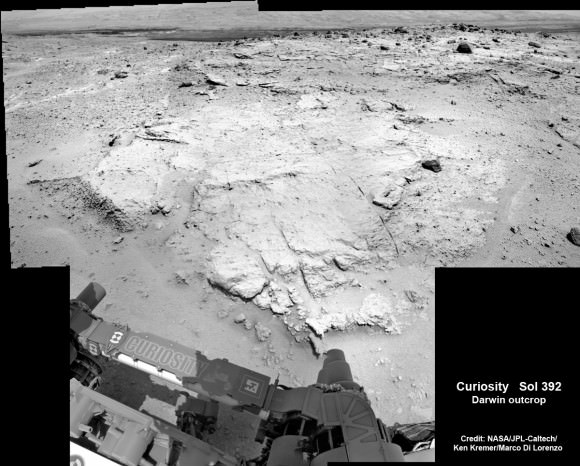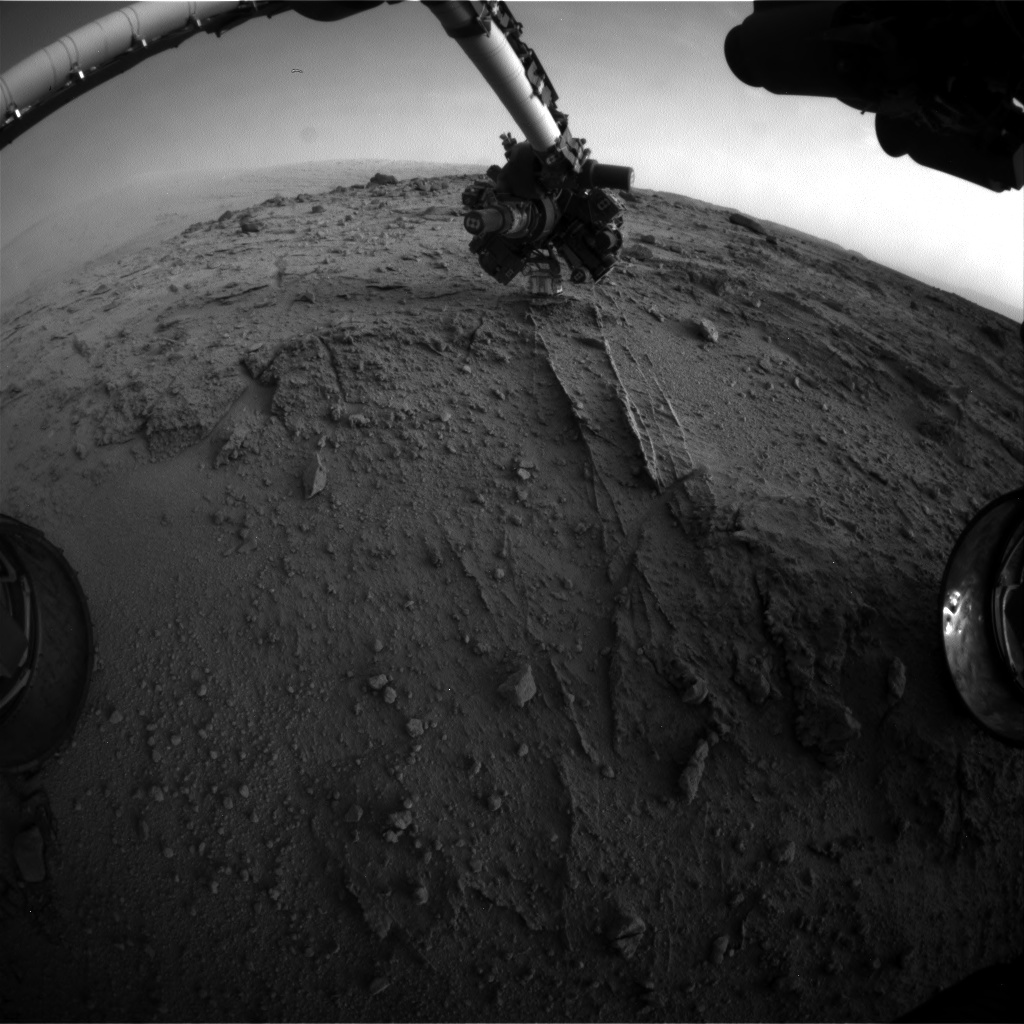NASA’s Curiosity rover has discovered a new patch of pebbles formed and rounded eons ago by flowing liquid water on the Red Planet’s surface along the route she is trekking across to reach the base of Mount Sharp – the primary destination of her landmark mission.
Curiosity made the new finding at a sandstone outcrop called ‘Darwin’ during a brief science stopover spot called ‘Waypoint 1’.
Before arriving at Waypoint 1, the question was- “Did life giving water once flow here on the Red Planet?
The answer now is clearly ‘Yes!’ – And it demonstrates the teams wisdom in pausing to inspect ‘Darwin’.
The discovery at Darwin is significant because it significantly broadens the area here that was altered by flowing liquid water.

The presence of water is an essential prerequisite for the formation and evolution of life.
“Curiosity has arrived at Waypoint 1,” project scientist John Grotzinger, of the California Institute of Technology in Pasadena, told Universe Today at the time.
The robot pulled into ‘Waypoint 1’ on Sept. 12 (Sol 392).
“It’s a chance to study outcrops along the way,” Grotzinger told me.

The six wheeled rover is in the initial stages of what is sure to be an epic trek across the floor of her landing site inside the nearly 100 mile wide Gale Crater – that is dominated by humongous Mount Sharp that reaches over 3 miles (5 Kilometers) into the red Martian Sky.
“We examined pebbly sandstone deposited by water flowing over the surface, and veins or fractures in the rock,” said Dawn Sumner of University of California, Davis, a Curiosity science team member with a leadership role in planning the stop, in a NASA statement about Darwin and Waypoint 1.
“We know the veins are younger than the sandstone because they cut through it, but they appear to be filled with grains like the sandstone.”

Waypoint 1 is the first of up to five waypoint stops planned along the roving route that stretches about 5.3 miles (8.6 kilometers) between the “Glenelg” area, where Curiosity worked for more than six months through the first half of 2013, and the currently planned entry point at the base of Mount Sharp.
To date, the robot has now driven nearly 20% of the way towards the base of the giant layered Martian mountain she will eventually scale in search of life’s ingredients.
“Darwin is named after a geologic formation of rocks from Antarctica,” Grotzinger informed Universe Today.
‘Waypoint 1’ was an area of intriguing outcrops that was chosen based on high resolution orbital imagery taken by NASA’s Mars Reconnaissance Orbiter (MRO) circling some 200 miles overhead.
Investigation of the conglomerate rock outcrop dubbed ‘Darwin’ was the top priority of the Waypoint 1 stop.
The finding of a cache of watery mineral veins was a big added science bonus that actually indicates a more complicated story in Mars past – to the delight of the science team.
“We want to understand the history of water in Gale Crater,” Sumner said.
“Did the water flow that deposited the pebbly sandstone at Waypoint 1 occur at about the same time as the water flow at Yellowknife Bay? If the same fluid flow produced the veins here and the veins at Yellowknife Bay, you would expect the veins to have the same composition.’
“We see that the veins are different, so we know the history is complicated. We use these observations to piece together the long-term history.”
The Rover inspected Darwin from two different positions over 4 days, or Martian Sols and conducted ‘contact science’ by deploying the robotic arm and engaging the science instrument camera and spectrometer mounted on the turret at the arms terminus.
The Alpha Particle X-ray Spectrometer (APXS) collected spectral measurements of the elemental chemistry and the Mars Hand Lens Imager is a camera showing the outcrops textures, shapes and colors.

What’s the origin of Darwin’s name?
“Darwin comes from a list of 100 names the team put together to designate rocks in the Mawson Quadrangle – Mawson is the name of a geologist who studied Antarctic geology,” Grotzinger told me.
“We’ll stay just a couple of sols at Waypoint 1 and then we hit the road again,” Grotzinger told me.
And indeed on Sept. 22, the rover departed Darwin and Waypoint 1 on a westward heading to resume the many months long journey to Mount Sharp.
…………….
Learn more about Curiosity, Mars rovers, MAVEN, Orion, Cygnus, Antares, LADEE and more at Ken’s upcoming presentations
Oct 3: “Curiosity, MAVEN and the Search for Life on Mars – (3-D)”, STAR Astronomy Club, Brookdale Community College & Monmouth Museum, Lincroft, NJ, 8 PM
Oct 8: NASA’s Historic LADEE Lunar & Antares/Cygnus ISS Rocket Launches from Virginia”; Princeton University, Amateur Astronomers Assoc of Princeton (AAAP), Princeton, NJ, 8 PM

